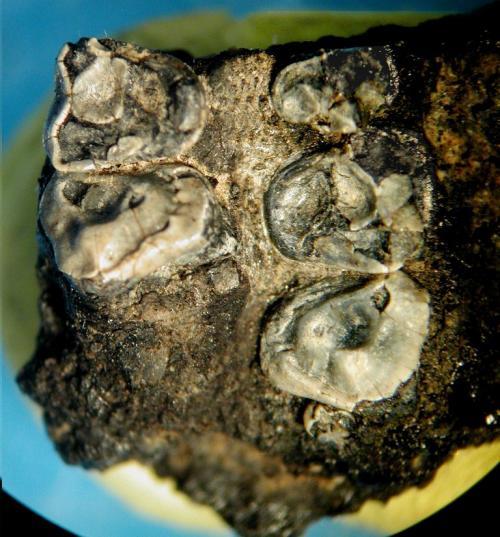Bob Yirka
Source - http://phys.org/news/2013-10-asian-early-anthropoid-thailand-coal.html

Krabia minuta fossil. Credit: Yaowalak Chaimanee
A newly discovered type of anthropoid (precursor to monkeys, apes and humans) has been discovered in a coal mine in Thailand. A team of French anthropologists from Université de Poitiers has been studying the fossil remains (newly named Krabia minuta) and have published a paper describing their findings in Proceedings of the Royal Society B: Biological Sciences.
Those who study human evolution have until recently believed that some types of animals arose in Africa and then evolved to become monkeys, apes and humans. The new thinking is that the precursors to all three developed first in Asia, not Africa, then somehow made their way across an ancient sea to develop into the apes, monkey's and people we see today. This new find in Thailand bolsters that theory, while also suggesting that some precursors were not precursors at all, but were instead relatives of precursors that either evolved into something else, or went extinct. The tiny primate fossil (estimated to weigh just half a pound when alive) was found in a coal mine and consisted of a single jawbone. The research team places the fossil to the Late Eocene, approximately 33-35 million years ago. Surprisingly, the teeth on the bone were unlike those of other anthropoids found in Asia, and suggest K. minuta ate fruit and gum, rather than the nuts and insects associated with other anthropoids. This, the researchers suggest, means that the little creature was likely part of group of anthropoids called amphipithecids, that lived throughout Southeast Asia and who all eventually went extinct.
Fossil evidence in China shows anthropoids living in that area as early as 45 million years ago—the earliest fossils in Africa date back to just 38 million years ago, suggesting that the first anthropoids were in Asia, not Africa. How they could have made their way across the Tethys Sea that separated Asia from Africa at the time is still a mystery. Some suggest it may have been the result of a natural event, such as a monsoon that pushed natural barges carrying animals across the sea—which was larger than the Mediterranean is today.
More information: A new Late Eocene primate from the Krabi Basin (Thailand) and the diversity of Palaeogene anthropoids in southeast Asia, Published 2 October 2013 DOI: 10.1098/rspb.2013.2268
Abstract
According to the most recent discoveries from the Middle Eocene of Myanmar and China, anthropoid primates originated in Asia rather than in Africa, as was previously considered. But the Asian Palaeogene anthropoid community remains poorly known and inadequately sampled, being represented only from China, Myanmar, Pakistan and Thailand. Asian Eocene anthropoids can be divided into two distinct groups, the stem group eosimiiforms and the possible crown group amphipithecids, but the phylogenetic relationships between these two groups are not well understood. Therefore, it is critical to understand their evolutionary history and relationships by finding additional fossil taxa. Here, we describe a new small-sized fossil anthropoid primate from the Late Eocene Krabi locality in Thailand, Krabia minuta, which shares several derived characters with the amphipithecids. It displays several unique dental characters, such as extreme bunodonty and reduced trigon surface area, that have never been observed in other Eocene Asian anthropoids. These features indicate that morphological adaptations were more diversified among amphipithecids than was previously expected, and raises the problem of the phylogenetic relations between the crown anthropoids and their stem group eosimiiforms, on one side, and the modern anthropoids, on the other side.